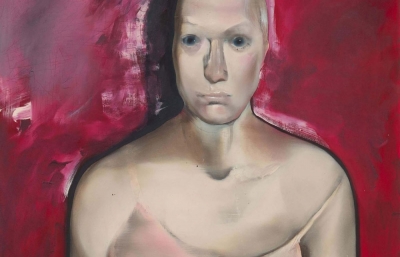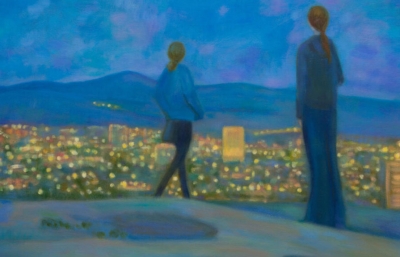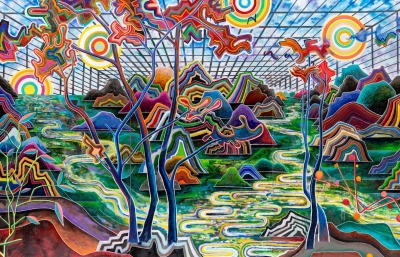I love your use of greens, berry hues, and deep, velvety blues. How do you choose your colors and then infuse the paintings with such richness? Tell us about the materials you use to achieve this.
The choice of colors is comparable to the horizon. It is not because we see it that we possess the sky. When I go to buy my tubes of paint, I first select by habit—the browns, blues, and greens are almost always the same. But I often let my intuition of the moment make its own choices. It’s kind of like going to a candy store—even if you know what you like, you’ll also pick out something new just to “try it out.” Voila, paint tubes and candy are the same!
I apply a lot of layers on my canvases, relatively thin ones in order to get an almost perfect flatness and also acquire the strongest contrasts. During my studies, one of my professors told me not to be afraid of color. Being a person who does not always control the reason with accuracy, I made the decision, to this day, that color would not be a fickle enemy, but a faithful excess. Creating harmony requires a confrontation in contradiction. It is elusive but fraternal.
Do the shadows in your rooms signify a way to retreat or run away, or are they conveyors of privacy, maybe liberation?
The shadow is only understood by the light and vice versa. It is both a compass and a clock, as it tells you something. The light, defined by the frame of a window reflected against a wall, is the sign of an off-field space, of something we cannot see directly, of the possibility of an elsewhere. This “elsewhere” is definable only by these lines and suggests the freedom to imagine what is there.
I don’t always paint in enclosed spaces. Some scenes represent the outside, sometimes also the nothingness. The shadow, lights, and perspectives are also sometimes deliberately false where there is no mixture of natural and artificial light, of chance and staging, or spontaneity and control. All these assemblies lose us in a confusion, the same one that constantly plunges us between digital life and the one we really live. With regard to the splendor, the weight of the shadow only obscures itself by its refusal to convince the light.
Some of the windows remind me of Magritte’s paintings of buildings at night. Who are some artists who influence you?
I’m a lover of history and don’t have room to name all the geniuses who have inspired me, whether in art, cinema, literature, or other genres, but artists who come to mind are Séraphine de Senlis, Edward Hopper, Camille Bombois, Giorgio de Chirico, Ed Ruscha, Emily Mae Smith and Robin F. Williams, whom I admire so much.
Although people don’t appear in your paintings, animals have. Why do you give them entry into your stories? How do you choose a particular animal and their role? And do you have a pet?
I have the pleasure of enjoying the company of a ghost of a cat, to whom I did not give a name because, not being of this world anymore, I consider that he can now be free to choose for himself. He is kind, attentive, and very quiet. It costs me nothing except the consciousness that it looks at me as soon as my back is turned. That helps for many things, I guess.
Have you painted portraits before? What attracts you to studying objects, especially many, like chairs, couches, and beds, that occupy people?
Is the ambiguous sense of absence due to the memory of shared moments? The consciousness of the present is linked to the possession of the intense until the fall of the ordinary. The absence of a human figure in an image does not mean that there is something missing because for this image to exist, then it is necessary to have someone look at it. And so, the portrait takes life without the subject knowing themselves that they are the main character of the scene they are looking at.












